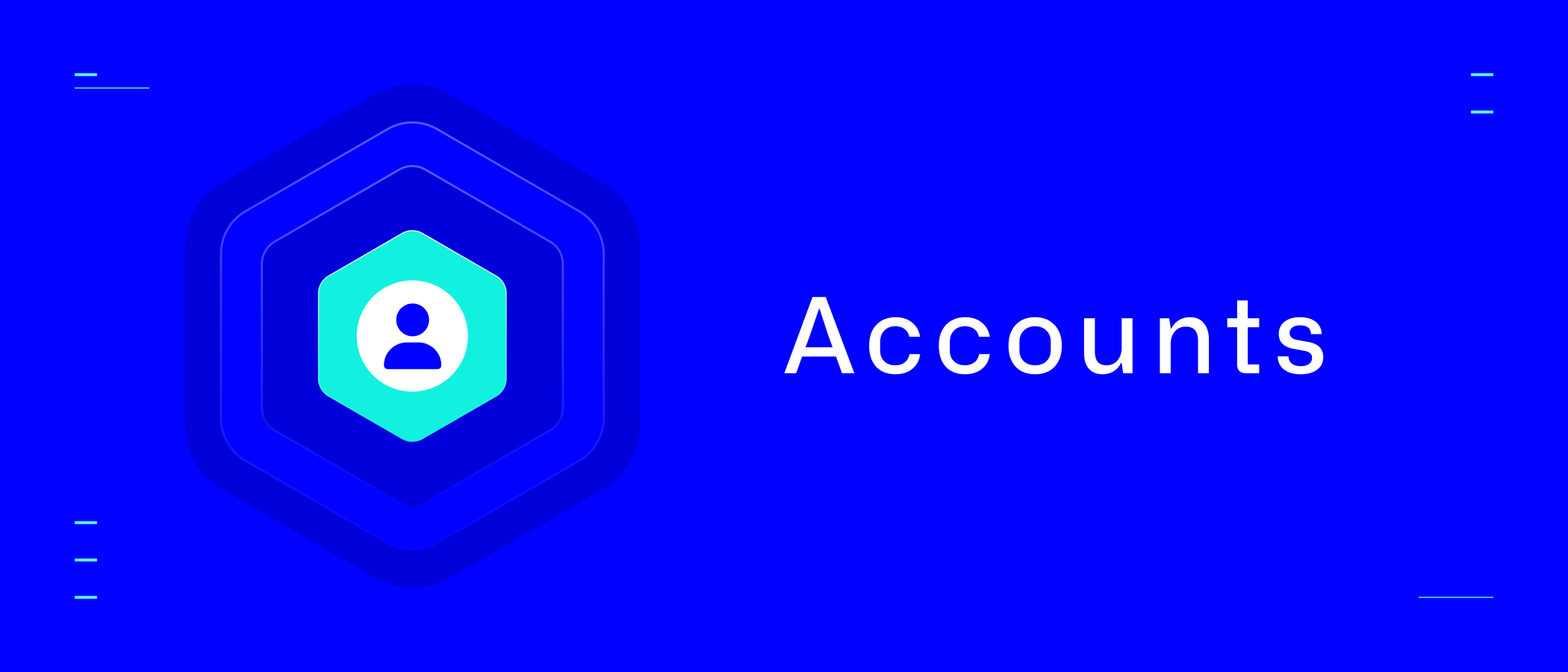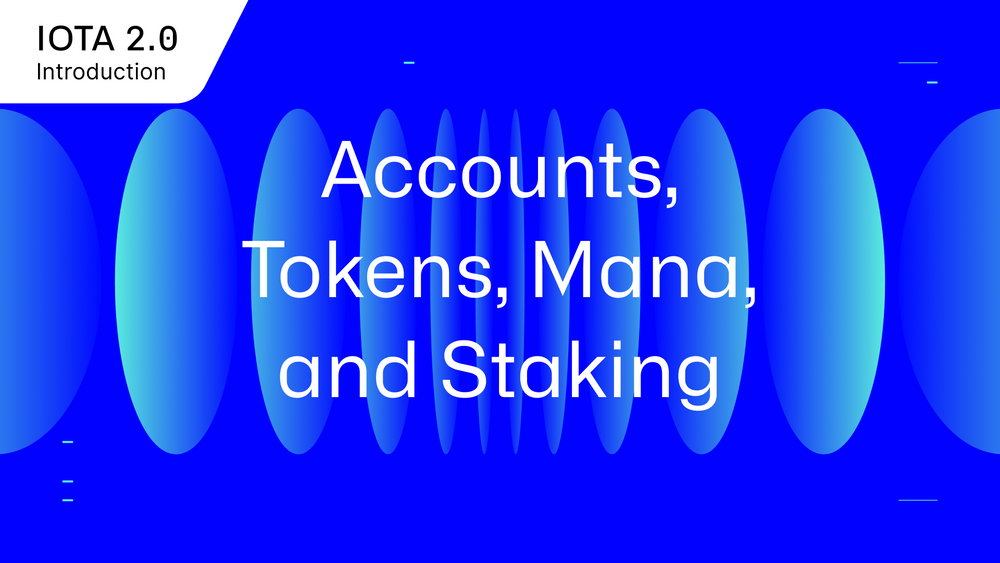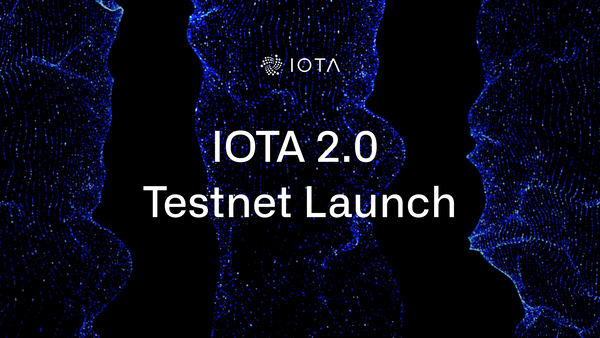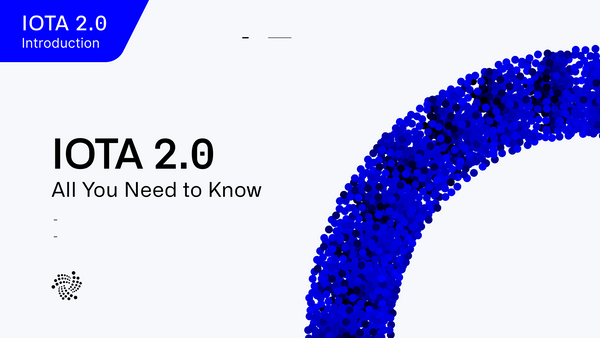Accounts, Tokens, Mana and Staking
IOTA 2.0 Introduction Part 5
TL;DR:
IOTA 2.0’s tokenomics revolves around two assets, IOTA tokens and Mana, accessible through decentralized accounts. IOTA tokens provide voting power and are fixed in supply to prevent inflation. Token holders can stake to validate the network or delegate to other users. Mana is generated by holding IOTA tokens and enables various network activities without intermediaries. IOTA's validators and delegators are rewarded with Mana, not fees, promoting fairness and decentralization.
Tokenomics are the economic principles and incentives that govern a cryptocurrency or digital token.
The IOTA 2.0 tokenomics model revolves around IOTA tokens and Mana. Both of these assets will be accessible through your account, from where you’ll be able to either stake your IOTA tokens and help validate the network or delegate them to a validator.
This blog post provides an overview of accounts, tokens, Mana, and staking. For a more detailed description, we recommend the Wiki version of this article. For an overview of how IOTA 2.0’s tokenomics benefits everyone equally, check out Fair Tokenomics for all Token Holders, scheduled for November 17th.

Accounts
If you want to participate in the IOTA economy, your first step will be to create an account, which you'll be able to use for any economic activity in the protocol. Accounts are decentralized, so they have no association with the IOTA Foundation or any other party.
Your account is a component on the ledger from which you can stake tokens as a validator, delegate tokens to other validators, claim Mana, and hold credits to issue blocks.
But accounts offer even more advantages. Thanks to IOTA Decentralized Identifiers, accounts can serve as a digital identity that is accessible, transparent, persistent, self-controlled, portable, and interoperable, thereby ensuring digital autonomy.
Let’s look at the two assets held by an account: IOTA tokens and Mana.

IOTA Tokens
Unlike traditional blockchain systems that continuously mint new tokens to reward their validators, the total amount of IOTA 2.0 tokens remains fixed, preventing inflation and preserving the value of your tokens.
Holding IOTA tokens also grants voting power in the consensus mechanism and for governance decisions.
However, the real driver behind IOTA tokenomics is the sustainable demand for IOTA tokens created by the utility of Mana, the essential resource for accessing and utilizing the IOTA ledger.

Mana
IOTA tokens generate Mana over time. Mana is a resource that allows you to perform certain actions on the IOTA 2.0 network – think of it like a loyalty score that unlocks features. Unlike most blockchain systems where block creation is reserved for a select group of validators, any IOTA account holder can use their Mana to create transactions and access features like transferring funds, minting an NFT, or engaging with smart contracts, all without having to pay intermediaries.
Each time you create a block on the IOTA network, it will consume Mana, meaning it is subtracted from the Mana balance in your account. The amount of Mana to be consumed depends on the network's congestion levels; nodes dynamically regulate this amount as transactions are processed.
IOTA 2.0’s congestion control distributes throughput (the rate or capacity at which transactions or data can be processed or transmitted) among the network’s users based on the amount of Mana they hold. So, holding IOTA tokens entitles the holder to a share of the network’s throughput capacity through their mana generation. In other words, investing in IOTA tokens ensures that the user will have a guaranteed minimum average throughput for as long as they desire.
How do I get Mana?
You can obtain Mana in different ways. While the primary way is by holding IOTA tokens, Mana can also be earned as a reward for participating in consensus by validating transactions. If you can’t spare the time or the effort to validate, you can also earn Mana by delegating your voting power to a validator and claiming a mutually agreed part of their reward – keep reading for more on this.
You can also purchase Mana directly from other holders on the network if, say, you lack IOTA tokens, temporarily require higher throughput, or cannot hold crypto tokens due to regulatory issues in your jurisdiction. This means that, even if you don’t hold IOTA tokens, you can still participate in the network by purchasing Mana.
Calculating Mana
In IOTA 2.0, each validator and delegator will know how much Mana on average they can expect to receive, and unlike other blockchains where gas fees shoot up due to congestion on the network, you’ll know the range of Mana that will be burned to process your transactions (to learn more about Mana, and how it accrues and decays over time, please refer to our Wiki).
The Mana Calculator is designed to provide reassurance, predictability, and a clear understanding of your potential Mana rewards based on whether you validate or delegate your IOTA tokens: check it out here.
Staking and Delegating
As mentioned above, Mana is given to anyone who helps validate the IOTA 2.0 network. But how do you validate?
There are actually two methods of validation: 1) validating blocks by locking up your funds (in other words, staking) or 2) delegating your voting power.
- Validation through staking is when you stake your IOTA tokens to potentially be selected to validate transactions on the network. In return, you'll be rewarded with Mana.
To become validators, users must run a node, lock up IOTA tokens, and register on the ledger as validators by adding a stake feature to their accounts. They are then selected periodically to form a validator committee. This committee regularly issues "validation blocks" that approve transactions.
The amount of Mana given as a reward for validation depends on how well the validators perform their duties, including issuing the expected rate of confirmed validation blocks, helping to confirm other blocks, the size of the stake, and how much voting power was delegated to them. - If you aren’t willing or able to lock up your tokens to perform the computational job of a validator, you will still be able to delegate the voting power of your tokens to a validator. This is done simply by specifying the validator's account ID during a token transfer. This process is called liquid delegation because it doesn’t lock up your tokens and you’re still rewarded with a share of the Mana reward earned by the validator you delegated to.
Rewarding Validators and Delegators with Mana
In other blockchain systems, validators are rewarded for their work with the base token and fees, gradually accumulating more wealth. There’s nothing wrong with this in principle: Validators perform a valuable job and should be rewarded! However, it diminishes the amount of other users' tokens due to the transaction fees they pay the validators. This can also make certain use cases extremely expensive (or even unsustainable) in the long run.
However, in IOTA 2.0, validators are rewarded without detracting base tokens from other users.
In IOTA 2.0, access will be paid with replenishable Mana, ensuring no one has to spend their IOTA tokens on fees.
But how will validators profit if they aren’t rewarded with fees or IOTA token inflation?
They profit in two ways. Firstly, their Mana rewards gain them additional throughput (and without paying fees). Secondly, validators can profit from selling their spare Mana to users who either lack IOTA tokens or occasionally require higher throughput. This creates a natural Mana market driven by network demand.
At the early stages of the network, the network's demand may not support a highly profitable Mana market. Therefore, validators and delegators receive proportionally more Mana during these early years, incentivizing early network security.
Mana is a critical component of the IOTA economy. By being granted to all participating users proportionally to their token holdings, whether they hold IOTA tokens or stake them and participate in consensus as delegators or validators, it ensures that the network remains open to all and access is distributed fairly without generating base token inflation. And, to prevent a monopoly over the supply of Mana in the system, the Mana you hold gradually decays over time: holding IOTA tokens guarantees the generation of new Mana while selling or disposing of your tokens means that your Mana will decay without any generation. So users will continuously contribute to the system to secure their Mana.
Benefits of the IOTA 2.0 Incentivization Model
Our incentivization model will create a community of validators and token holders, all rewarded according to their contributions to securing the network and processing transactions efficiently.
The IOTA incentivization model will promote four key benefits:
- It's permissionless, so anyone can participate in the consensus. All actors are rewarded fairly according to their stake and participation.
- It’s committed to the security of the network, with staked tokens locked up to stabilize voting power distribution and protect the protocol against exploits. It encourages staked tokens to be locked up by offering increased rewards compared to delegating tokens. This makes the protocol less susceptible to exploits since it tends to stabilize the distribution of voting power and encourages ‘good’ behavior by validators, who will have tokens invested in the network while performing validation duties.
- It features liquid delegation, which allows token holders to delegate their voting power without locking up their tokens, and thus commit to network functionality and security even if they aren’t willing or able to perform the computational job of a validator.
- It disincentivizes the concentration of delegated stake on a single validator by reducing rewards for delegators in such cases. This encourages delegators to choose validators with less delegated stake, leading to a stable ratio of delegated and validator stake in the system.
Together, these benefits will create a community of validators and token holders, all being rewarded proportionally for their contributions to securing the network and processing transactions efficiently.
Instead of wealth flowing in one direction from the system’s users to its maintainers, all IOTA token holders will be rewarded with Mana that they can utilize to access the network. Read more about this in Fair Tokenomics for all Token Holders, part 13 of this blog post series, to be published on November 17th.
For a more in-depth introduction to these topics, check out the Wiki version of this article. In our next blog post, we look deeper into consensus, committees, approval weight, and the finality gadget.
Join the conversation on X
🌐 One of #IOTA 2.0's 5 core principles is Sustainable Tokenomics, which is achieved through a resource called Mana🔋. But what is it? And how does Mana maximize utility and encourage long term investment? 🧵⬇️ pic.twitter.com/pKzYYbe6y0
— IOTA (@iota) October 13, 2023
OTA 2.0 Introduction
Part 1: Digital Autonomy for Everyone: The Future of IOTA
Part 2: Five Principles: The Fundamentals That Every DLT Needs
Part 3: Data Flow Explained: How Nodes Process Blocks
Part 4: Data Structures Explained: The Building Blocks that Make the Tangle
Part 5: Accounts, Tokens, Mana and Staking
Part 6: A New Consensus Model: Nakamoto Consensus on a DAG
Part 7: Confirming Blocks: How Validators Operate
Part 8: Congestion Control: Regulating Access in a Permissionless System
Part 9: Finality Explained: How Nodes Sync the Ledger
Part 10: An Obvious Choice: Why DAGs Over Blockchains?
Part 11: What Makes IOTA 2.0 Secure?
Part 12: Dynamic Availability: Protocol-Based Assurances
Part 13: Fair Tokenomics for all Token Holders
Part 14: UTXO vs Accounts: Merging the Best of Both Worlds
Part 15: No Mempool, No MEV: Protecting Users Against Value Extraction
Part 16: Accessible Writing: Lowering the Barriers to Entry




